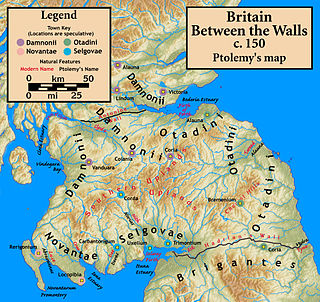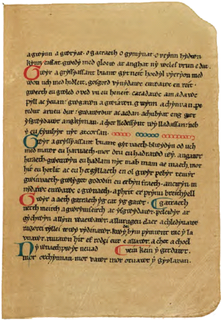Related Research Articles

The Gododdin were a Brittonic people of north-eastern Britannia, the area known as the Hen Ogledd or Old North, in the sub-Roman period. Descendants of the Votadini, they are best known as the subject of the 6th-century Welsh poem Y Gododdin, which memorialises the Battle of Catraeth and is attributed to Aneirin.
Taliesin was an early Brittonic poet of Sub-Roman Britain whose work has possibly survived in a Middle Welsh manuscript, the Book of Taliesin. Taliesin was a renowned bard who is believed to have sung at the courts of at least three kings.
Bernicia was an Anglo-Saxon kingdom established by Anglian settlers of the 6th century in what is now southeastern Scotland and North East England.
Aneirin[aˈnɛirɪn] or Neirin was an early Medieval Brythonic war poet. He is believed to have been a bard or court poet in one of the Cumbric kingdoms of the Hen Ogledd, probably that of Gododdin at Edinburgh, in modern Scotland. From the 17th century, he was usually known as Aneurin.
Cumbric was a variety of the Common Brittonic language spoken during the Early Middle Ages in the Hen Ogledd or "Old North" in what is now Northern England and southern Lowland Scotland. It was closely related to Old Welsh and the other Brittonic languages. Place name evidence suggests Cumbric may also have been spoken as far south as Pendle and the Yorkshire Dales. The prevailing view is that it became extinct in the 12th century, after the incorporation of the semi-independent Kingdom of Strathclyde into the Kingdom of Scotland.

The Votadini, also known as the Uotadini, Wotādīni, Votādīni or Otadini, were a Brittonic people of the Iron Age in Great Britain. Their territory was in what is now south-east Scotland and north-east England, extending from the Firth of Forth and around modern Stirling to the River Tyne, including at its peak what are now the Falkirk, Lothian and Borders regions and Northumberland. This area was briefly part of the Roman province of Britannia. The earliest known capital of the Votadini appears to have been the Traprain Law hill fort in East Lothian, until that was abandoned in the early 5th century. They afterwards moved to Din Eidyn (Edinburgh).

Y Gododdin is a medieval Welsh poem consisting of a series of elegies to the men of the Brittonic kingdom of Gododdin and its allies who, according to the conventional interpretation, died fighting the Angles of Deira and Bernicia at a place named Catraeth in about AD 600. It is traditionally ascribed to the bard Aneirin and survives only in one manuscript, the Book of Aneirin.

The Book of Aneirin is a late 13th century Welsh manuscript containing Old and Middle Welsh poetry attributed to the late 6th century Northern Brythonic poet, Aneirin, who is believed to have lived in present-day Scotland.
Madoc or Madog was a legendary Welsh prince who allegedly discovered America in 1170.
Geraint son of Erbin is a medieval Welsh poem celebrating the hero Geraint and his deeds at the Battle of Llongborth. The poem consists of three-line englyn stanzas and exists in several versions all in Middle Welsh. The earliest surviving version is in the Black Book of Carmarthen, completed around 1250, though the poem may have been composed in the 10th or 11th century. The poem is significant for its early mention of King Arthur.

Yr Hen Ogledd, in English the Old North, is the historical region which is now Northern England and the southern Scottish Lowlands that was inhabited by the Brittonic people of sub-Roman Britain in the Early Middle Ages. Its population spoke a variety of the Brittonic language known as Cumbric which is closely related to, if not a dialect of Old Welsh. The people of Wales and the Hen Ogledd considered themselves to be one people and both were referred to as Cymry ('fellow-countrymen') from the Brittonic word combrogi. The Hen Ogledd was distinct from the parts of North Britain inhabited by the Picts, Anglo-Saxons, and Scoti.
The name Edinburgh is used in both English and Scots for the capital of Scotland; in Scottish Gaelic, the city is known as Dùn Èideann. Both names are derived from an older name for the surrounding region, Eidyn. It is generally accepted that this name in turn derives ultimately from the Celtic Common Brittonic language.
The Battle of Catraeth was fought around AD 600 between a force raised by the Gododdin, a Brythonic people of the Hen Ogledd or "Old North" of Britain, and the Angles of Bernicia and Deira. It was evidently an assault by the Gododdin party on the Angle stronghold of Catraeth, perhaps Catterick, North Yorkshire. The Gododdin force was said to have consisted of warriors from all over the Hen Ogledd, and even some from as far afield as Gwynedd in North Wales and Pictland. The battle was disastrous for the Britons, who were nearly all killed. The slain warriors were commemorated in the important early poem Y Gododdin, attributed to Aneirin.

Manaw Gododdin was the narrow coastal region on the south side of the Firth of Forth, part of the Brythonic-speaking Kingdom of Gododdin in the post-Roman Era. It is notable as the homeland of Cunedda prior to his conquest of North Wales, and as the homeland of the heroic warriors in the literary epic Y Gododdin. Pressed by the Picts expanding southward and the Northumbrians expanding northward, it was permanently destroyed in the 7th century and its territory absorbed into the then-ascendant Kingdom of Northumbria.
Mynyddog Mwynfawr was, according to Welsh tradition founded on the early Welsh language poem Y Gododdin, a Brittonic ruler of the kingdom of Gododdin in the Hen Ogledd.
Gweith Gwen Ystrat, is a late Old Welsh or Middle Welsh heroic poem found uniquely in the Book of Taliesin, where it forms part of the Canu Taliesin, a series of poems attributed to the 6th-century court poet of Rheged, Taliesin.

Aeron was a kingdom of the Brythonic-speaking Hen Ogledd, presumed to have been located in the region of the River Ayr in what is now southwestern Scotland. It existed during the post-Roman era, perhaps earlier, and disappeared before or during the 7th-century conquest of the region by the ascendant Kingdom of Northumbria.

Cynon ap Clydno or in some translations Kynon or Cynan was an Arthurian hero from Welsh mythology. His quest to the Castle of Maidens and his subsequent trial against the Black Knight, serve as a prelude to the adventure of Owain and The Lady of the Fountain. Cynon is closely associated with Sir Calogrenant, who takes his role in other versions of the tale.

Eidyn was the region around modern Edinburgh in Britain's sub-Roman and early medieval periods, approximately the 5th–7th centuries. It centred on the stronghold of Din Eidyn, thought to have been at Castle Rock, now the site of Edinburgh Castle, and apparently included much of the area below the Firth of Forth. It was the most important district of the Brittonic kingdom of Gododdin, and a significant power in the Hen Ogledd, or Old North, the Brittonic-speaking area of what is now southern Scotland and northern England.

"Dinogad's Smock" or "Dinogad's Cloak" is an Old Welsh lullaby recounting the hunting prowess of the dead father of an infant named Dinogad, who is wrapped in a smock made of marten skins. This garment gives the poem its modern title.
References
- ↑ K. Jongeling, Hwn yw e gododin. aneirin ae cant (Gouda 2016), pp. 33-34 (XCVI, 93, B 22).
- 1 2 The Gododdin of Aneirin: Text and Context from Dark-Age North Britain, ed. by John T. Koch (Cardiff: University of Wales Press, 1997), pp. 50-51 (lines 1174-79; B 22). ISBN 0708313744.
- ↑ K. H. Jackson, The Gododdin: The Oldest Scottish Poem (Edinburgh: Edinburgh University Press, 1969), p. 106.
- ↑ K. H. Jackson, The Gododdin: The Oldest Scottish Poem (Edinburgh: Edinburgh University Press, 1969), pp. 106, 109, 116, 129, 143.
- ↑ Peter C. Bartrum, A Welsh Classical Dictionary: People in History and Legend up to about A.D. 1000 ([Aberystwyth]: National Library of Wales, 1993), s.v. Madog Elfed.
- ↑ Mark Reginald Wakeford, 'The British Church and Anglo-Saxon Expansion: The Evidence of Saints' Cults' (unpublished Ph.D. theses, Durham University, 1998), pp. 17-19.
- ↑ Tim Clarkson, The Men of the North: The Britons of Southern Scotland (Edinburgh: Donald, 2010), ISBN 978-1-906566-18-0.